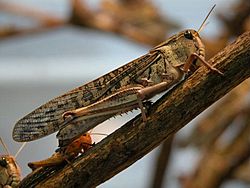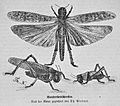Migratory locust facts for kids
Quick facts for kids Migratory locust |
|
|---|---|
 |
|
| Female migratory locust | |
| Scientific classification | |
| Kingdom: | |
| Phylum: | |
| Class: | |
| Order: | |
| Suborder: | |
| Family: | |
| Genus: |
Locusta
|
| Binomial name | |
| Locusta migratoria (Linnaeus, 1758)
|
|
The migratory locust (Locusta migratoria) is a very common type of locust. It is the only species in its group, called Locusta. You can find these locusts all over Africa, Asia, Australia, and New Zealand. They used to be common in Europe but are now rare there.
Because they live in so many different places, there are many types of migratory locusts. Not all scientists agree on how many different types there are. Many other grasshopper species that live in groups and travel long distances are also called 'locusts'.
Contents
Amazing Transformations: Solitary and Swarming Locusts
Migratory locusts are special because they can change how they look and act. This is called polyphenism. It means one type of animal can have two or more very different forms. These forms depend on things in their environment.
For the migratory locust, the biggest change happens because of how many other locusts are around. If there are only a few locusts, they live a solitary (alone) life. But if many locusts are in one place, they switch to a gregarious (group-living) phase.
How They Change Their Look
The color and size of a migratory locust change depending on its phase and age.
- Young gregarious locusts (larvae) are yellow or orange with black spots.
- Young solitary locusts are green or brown. This helps them blend in with plants.
When they become adults:
- Gregarious adults are brownish with yellow. The yellow color gets brighter as they get older.
- Solitary adults are brown. They can also have green parts, depending on the plants they live on.
Gregarious adults are usually smaller than solitary adults. They are about 40 to 60 millimeters long.
Images for kids
See also
 In Spanish: Langosta migratoria para niños
In Spanish: Langosta migratoria para niños











